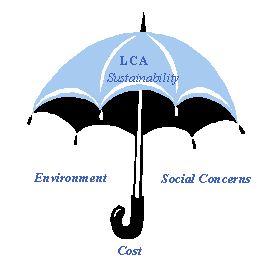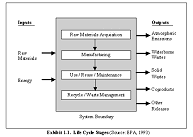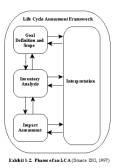
LCA
Explored
Introduction
As we have mentioned so far, worldwide environmental awareness increases as part of the wider sustainable ethos and for that industries and businesses have started to assess how their activities affect the environment. Society has become concerned about the issues of natural resource depletion and environmental degradation. Many businesses have responded to this awareness by providing "greener" products and using "greener" processes. The environmental performance of products and processes has become a key issue, which is why some companies are investigating ways to minimize their effects on the environment. Many companies have found it advantageous to explore ways of moving beyond compliance using pollution prevention strategies and environmental management systems to improve qualitatively their environmental performance.
One tool for identifying quantitatively environmental impacts is currently life cycle assessment (LCA) method. This concept considers the entire life cycle of a product. Life cycle assessment is a "cradle-to-grave" approach for assessing industrial systems. "Cradle-to-grave" begins with the gathering of raw materials from the earth to create the product and ends at the point when all materials are returned to the earth. LCA evaluates all stages of a product's life from the perspective that they are interdependent, meaning that one operation leads to the next. LCA enables the estimation of the cumulative environmental impacts resulting from all stages in the product life cycle, often including impacts not considered in more traditional analyses (e.g., raw material extraction, material transportation, ultimate product disposal, etc.). By including the impacts throughout the product life cycle, LCA provides a comprehensive view of the environmental aspects of the product or process and a more accurate picture of the true environmental trade-offs in product selection.
Definitions
We present below the two of the most widely accepted definitions about LCA, as they have been chronologically formulated to date.
The Society of Environmental Toxicology and Chemistry defines Life Cycle Assessment as follows: “The life cycle assessment is an objective process to evaluate the environmental burdens associated with a product, process, or activity by identifying and quantifying energy and material usage and environmental releases, to assess the impacts of those energy and material uses and releases to the environment, and to evaluate and implement opportunities to effect environmental improvements. The assessment includes the entire life cycle of the product, process, or activity, encompassing extracting and processing raw materials; manufacturing transportation and distribution; use/re-use/maintenance; recycling, and final disposal.” (Guidelines for Life-Cycle Assessment: A 'Code of Practice', SETAC, Brussels, 1993)
·
ISO 14040 defines Life Cycle Assessment as follows: "LCA
is a technique for assessing the environmental aspects and potential
impacts associated with a product by:
1.
Compiling an inventory of relevant inputs and outputs of a product
system;
2.
Evaluating the potential environmental impacts associated with
those inputs and outputs;
3.
Interpreting the results of the inventory analysis and impact
assessment phases in relation to the objectives of the study.
LCA
studies the environmental aspects and potential impacts throughout the
product's life (i.e. cradle to grave) from raw materials acquisition
through production, use and disposal. The general categories of
environmental impacts needing consideration include resource use, human
health, and ecological consequences”.
To paraphrase the above definitions, LCA is a systematic and holistic approach to green buildings. By our investigation we realised that a common trap in some notions of green buildings is the tendency to focus only on choosing low-impact materials during the construction phase of the residential building. But green building design with the aid of the LCA process breaks out of this trap. So instead of only trying to retrofit an existing blueprint with low-impact construction materials and energy efficient fluids systems, LCA brings environmental concerns to the design level as it evaluates how best to minimize environmental impacts not only during the construction phase, but also during the use of the residential building during its entire life cycle. As the team realised, by completion of the project, this approach has inherent trade-offs at every level, but since it is a holistic approach, the sum of these trade-offs eventually leads to a smaller life cycle environmental impact.
Presenting Project Methodology
Having seen the basic characteristics of LCA we can proceed to the way it is being used today by corporations and organisations in an attempt to describe the steps we followed to complete our work on our case study.
As a technique LCA assess the environmental aspects and potential impacts associated with a product, process, or service, by:
· Compiling an inventory of relevant energy and material inputs and environmental releases;
· Evaluating the potential environmental impacts associated with identified inputs and releases;
· Interpreting the results to help you make a more informed decision.
Exhibit 1-1 illustrates the possible life cycle stages that can be considered in an LCA and the typical inputs/outputs measured.

As a process it can be considered as a systematic and phased approach, which consists of four components: goal definition and scope, inventory analysis, impact assessment, and interpretation as illustrated in Exhibit 1-2 [11]:

Current LCA Utilisation in Engineering Market
The current interest in LCA comes from government, industry and consumer and environmental groups. At the outset that interest in LCA reflects two things:
· A broad shift to a more sophisticated, holistic, system-oriented approach to reducing environmental impact;
· A shift in investment based upon an acceptance by industry (at least in Europe, USA and, lately, Japan) that environmental concern is not transitory and that significant changes to all stages of production, from resource availability to product disposal, are inevitable.
Generally there are two types of models that are used by today’s organizations. Refined LC models [12] are cost oriented and are utilised for comparisons, selections and decisions of products against the financial and environmental visions of a company. On the other hand Enlarged LC models stretch from economical to environmental dimensions of a life assessment of a product to provide sufficient information about longer, strategic, planning and broader market investment [13].
Methodology Explained
In accordance with ISO standards, the process to complete successfully an LCA must be based on four phases, which we defined above in the “Presenting Project Methodology” section. Here we are giving a more analytical idea about what is involved in accommodating this methodology, offering an insight of the frame that it is built on and helping other party to understand the intimate points of our project work.
Goal Definition and Scope
Goal
definition and scope is the phase of the LCA process that defines the
purpose and method of including life cycle environmental impacts into the
decision-making process. In this phase, the following items must be
determined: the type of information that is needed to add value to the
decision-making process, how accurate the results must be to add value,
and how the results should be interpreted and displayed in order to be
meaningful and usable. The LCA process can be used to determine the
potential environmental impacts from any product, process, or service. The
goal definition and scope of the LCA project will determine the time and
resources needed. The defined goal and scope will guide the entire process
to ensure that the most meaningful results are obtained. Every decision
made throughout the goal definition and scope phase impacts either how the
study will be conducted, or the relevance of the final results. The
following section identifies the decisions that must be made at the
beginning of the LCA study and the impact of these decisions on the LCA
process.
Life
Cycle Inventory
A life cycle inventory is a process of quantifying energy and raw material requirements, atmospheric emissions, waterborne emissions, solid wastes, and other releases for the entire life cycle of a product, process, or activity (EPA 1993). In the life cycle inventory phase of an LCA, all relevant data is collected and organized. Without an LCI, no basis exists to evaluate comparative environmental impacts or potential improvements. The level of accuracy and detail of the data collected is reflected throughout the remainder of the LCA process. Life cycle inventory analyses can be used in various ways. They can assist an organization in comparing products or processes and considering environmental factors in material selection. In addition, inventory analyses can be used in policy-making, by helping the government develop regulations regarding resource use and environmental emissions. An inventory analysis produces a list containing the quantities of pollutants released to the environment and the amount of energy and material consumed. The results can be segregated by life cycle stage, by media (air, water, land), by specific processes, or any combination thereof.
Life Cycle Impact Assessment
The Life Cycle Impact Assessment (LCIA) phase of an LCA is the evaluation of potential human health and environmental impacts of the environmental resources and releases identified during the life cycle inventory (LCI). Impact assessment should address ecological and human health effects; it can also address resource depletion. A life cycle impact assessment attempts to establish a linkage between the product or process and its potential environmental impacts. For example, what are the impacts of 9,000 tons of carbon dioxide or 5,000 tons of methane emissions released into the atmosphere? Which is worse? What are their potential impacts on smog and global warming?
The key concept in this component is that of stressors. A stressor is a set of conditions that may lead to an impact. For example, if a product or process is emitting greenhouse gases, the increase of greenhouse gases in the atmosphere may contribute to global warming. Processes that result in the discharge of excess nutrients into bodies of water may lead to eutrophication. An LCIA provides a systematic procedure for classifying and characterizing these types of environmental effects.
Although much can be learned about a process by considering the life cycle inventory data, an LCIA provides a more precise basis to make comparisons. For example, although we know that 9,000 tons of CO2 and 5,000 tons of methane released into the atmosphere are both harmful, an LCIA can determine which could have a greater potential impact. Using science-based characterization factors, an LCIA can calculate the impacts each environmental release has on problems such as smog or global warming. An impact assessment can also incorporate value judgements. In an air non-attainment zone, for example, air emissions could be of relatively higher concern than the same emission level in a region with better air quality.
The results of an LCIA provide a checklist showing the relative differences in potential environmental impacts for each option. For example, an LCIA could determine which product/process causes more greenhouse gases, or could potentially kill more fish. The following steps comprise a life cycle impact assessment.
1. Selection and Definition of Impact Categories - identifying relevant environmental impact categories (e.g., global warming, acidification, terrestrial toxicity). [14]
2. Classification - assigning LCI results to the impact categories (e.g., classifying CO2 emissions to global warming).
3. Characterization - modelling LCI impacts within impact categories using science-based conversion factors. (e.g., modelling the potential impact of CO2 and methane on global warming). [15]
4. Normalization - expressing potential impacts in ways that can be compared (e.g. comparing the global warming impact of CO2 and methane for the two options).
5. Grouping - sorting or ranking the indicators (e.g. sorting the indicators by location: local, regional, and global).
6. Weighting - emphasizing the most important potential impacts.
7. Evaluating and Reporting LCIA Results - gaining a better understanding of the reliability of the LCIA results.
The
International Organization of Standardization (ISO) [16]
developed a standard
for conducting an impact assessment entitled ISO 14042, Life Cycle Impact
Assessment (ISO 1998), which states that the first three steps - impact
category selection, classification, and characterization - are mandatory
steps for an LCIA. Except for data evaluation (Step 7), the other steps
are optional depending on the goal and scope of the study.
Life
Cycle Interpretation
Life cycle interpretation is a systematic technique to identify, quantify, check, and evaluate information from the results of the life cycle inventory (LCI) and the life cycle impact assessment (LCIA), and communicate them effectively. Life cycle interpretation is the last phase of the LCA process.
The International Organization for Standardization (ISO) has defined the following two objectives of life cycle interpretation:
1. Analyse results, reach conclusions, explain limitations and provide recommendations based on the findings of the preceding phases of the LCA and to report the results of the life cycle interpretation in a transparent manner.
2. Provide a readily understandable, complete, and consistent presentation of the results of an LCA study, in accordance with the goal and scope of the study. (ISO 1998b)
Interpreting the results of an LCA is not as simple as: “2” is better then “3”, therefore alternative A is the best choice. While conducting the LCI and LCIA it is necessary to make assumptions, engineering estimates, and decisions based on your values and the values of involved stakeholders. Each of these decisions must be included and communicated within the final results to clearly and comprehensively explain conclusions drawn from the data. In some cases, it may not be possible to state that one alternative is better than the others because of the uncertainty in the final results. This does not imply that efforts have been wasted. The LCA process will still provide decision-makers with a better understanding of the environmental and health impacts associated with each alternative, where they occur (locally, regionally, or globally), and the relative magnitude of each type of impact in comparison to each of the proposed alternatives included in the study. This information more fully reveals the pros and cons of each alternative.